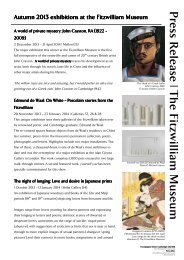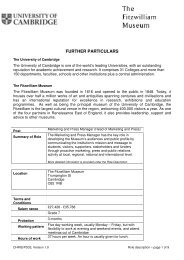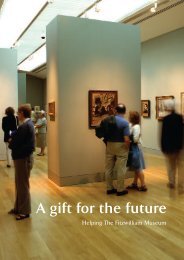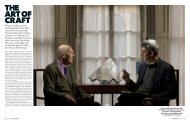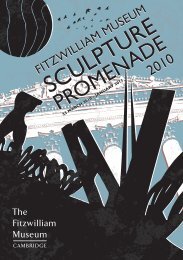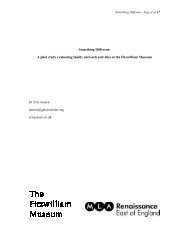The Fitzwilliam Museum - University of Cambridge
The Fitzwilliam Museum - University of Cambridge
The Fitzwilliam Museum - University of Cambridge
Create successful ePaper yourself
Turn your PDF publications into a flip-book with our unique Google optimized e-Paper software.
Joseph Wright<br />
(1734–1797)<br />
A lighthouse on fire at night<br />
Oil on canvas<br />
36.2 x 50.8 cm<br />
Purchased from the Fairhaven<br />
and Cunliffe Funds with a grant<br />
from the National Lottery through<br />
the Heritage Lottery Fund, and a<br />
contribution from the Friends <strong>of</strong><br />
the <strong>Fitzwilliam</strong> <strong>Museum</strong>.<br />
PD.33-2006<br />
Wright visited Italy between 1773 and 1775,<br />
where he developed his growing interest in<br />
landscape painting and was inspired by the<br />
works <strong>of</strong> contemporaries active in Rome at<br />
the time, notably Joseph Vernet (1714–1789).<br />
A version <strong>of</strong> the same scene at Tate Britain,<br />
painted in calmer conditions, with a more<br />
limpid, reflective light, suggests that he was<br />
also inspired by Vernet’s habit <strong>of</strong> painting<br />
landscape and coastal views as pairs,<br />
contrasting atmospheric effects at different<br />
times <strong>of</strong> the day.<br />
This dramatic, moonlit landscape was<br />
painted for John Leigh Philips (1761–1814),<br />
one <strong>of</strong> Wright’s closest friends in his later<br />
years. Philips was a successful silk weaver<br />
and among the most significant<br />
collectors <strong>of</strong> books, paintings, drawings<br />
and prints in Manchester. In December<br />
1792, Wright wrote to Philips from Italy<br />
explaining the growing appeal which<br />
landscape painting exercised over him:<br />
‘I know not how it is, tho’ I am ingaged<br />
in portraits … I find myself continually<br />
stealing <strong>of</strong>f, and getting into Landscapes.’<br />
Although the subject is developed from<br />
a sketch <strong>of</strong> Vesuvius from the Mole<br />
(1774, Derby City <strong>Museum</strong> and Art<br />
Gallery), the landscape is also based on<br />
that at Whitby on the Yorkshire coast.<br />
57<br />
Major Acquisitions



